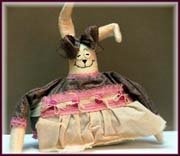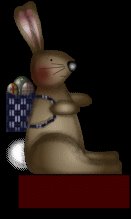 Who doesn't love cute, cuddly bunnies. Crafters and doll makers certainly do. When a crafter thinks of Easter or Spring they generally think bunnies and eggs. They've become a staple of Easter and Spring.
Who doesn't love cute, cuddly bunnies. Crafters and doll makers certainly do. When a crafter thinks of Easter or Spring they generally think bunnies and eggs. They've become a staple of Easter and Spring.Why? Because like many other items crafters can do so many things with them. They can be Victorian, Primitive, Country, even Shabby Chic. They can be made of fur, cloth, wood, metal, just about anything. They can be colorful or bleak. They can have clothes or no clothes. They can be cuddly or firm. They can be standing, sitting, even hopping. They can be toys, dolls, knick-knacks, graphics, cartoons, candy, signs, pictures, etc. Just about anything you can imagine. The sky's the limit.
So, where did all the fascination and tradition of bunnies being associated with Easter and Spring begin. As with a lot of our traditions bunnies (or really, hares) have their origins in pre-Christian or pagan folklore. They served as symbols of abundant new life in the Spring. It was decided that Easter would always be the first Sunday following a full moon. So, since the moon was used to determine the date for Easter and the hare was the Egyptian symbol for the moon, hares became associated with Easter. Hares are nocturnal like the moon and carry their young for a month before giving birth, which is like the changing moon with its monthly full moon. It was also believed that the hare always kept its eyes open, watching the moon.
According to some pagan folklore, the Easter bunny was originally a large bird belonging to the goddess Eostre. To entertain her children she magically changed her favorite pet bird into a hare, which immediately laid colorful and magical eggs. So, because the Easter bunny was really a bird at heart he continued to build a straw nest and fill it with eggs.
Eggs were dyed and eaten during the Spring festivals in ancient Egypt, Greece, Persia, and Rome and were given as gifts to celebrate the coming of Spring. In all cultures the egg symbolizes the beginning of life or the universe. The early Christians didn't feel that the pagan custom of coloring eggs was harmful so they kept that pagan tradition and applied it to their own festivities. Some speculate that missionaries or Knights of the Crusades were responsible for bringing the coloring of eggs westward.
The earliest known reference to a modern Easter Bunny appears in German writings in 16th century Germany. In medieval times eggs were traditionally given at Easter to the servants. The first edible Easter bunnies were made in Germany during the early 1800's and were made of pastry and sugar.
 In the 18Th century, German settlers brought the Easter Bunny tradition to America. The white Easter Bunny was called "Oschter Haws" or "Osterhase" and brought gifts of chocolate candy to good children. The children believed that if they were good the "Oschter Haws" would lay colorful eggs for them in a nest the children had built, which was usually a hat or bonnet that was placed in a secluded place like the barn or the garden.
In the 18Th century, German settlers brought the Easter Bunny tradition to America. The white Easter Bunny was called "Oschter Haws" or "Osterhase" and brought gifts of chocolate candy to good children. The children believed that if they were good the "Oschter Haws" would lay colorful eggs for them in a nest the children had built, which was usually a hat or bonnet that was placed in a secluded place like the barn or the garden.Placing the hats or bonnets in secluded places eventually lead to the Easter Hunts. On Easter morning the children of the house would join together in a search for the eggs that the Easter Bunny had hidden while they were asleep.
By the 19Th century the Easter Hare became the Easter Rabbit. Plastic Easter eggs made their debut in the early 1960's with more than 1 million plastic eggs being purchased each year for Easter. American families would later change the tradition of the nest into using baskets and giving chocolate as well as money. And, today, we know how commercial all of this has become. Easter baskets are no longer just filled with candy eggs. It's amazing how a simple tradition has become such a commercial affair.
In any event, now you know why bunnies are associated with Easter and Spring. I suspect that crafters will continue with their love affair with bunnies for a long time to come. They're just so versatile. Besides, how can you not love a bunny? They're just so cute, so cuddly, so fuzzy, so warm, so....
Oh, here comes Peter Cottontail!
Hopping down the bunny trail,
Hippity hoppity, Happy Easter Day!"
Hopping down the bunny trail,
Hippity hoppity, Happy Easter Day!"
Graphic courtesy of Becky at www.primsandstems.com

No comments:
Post a Comment